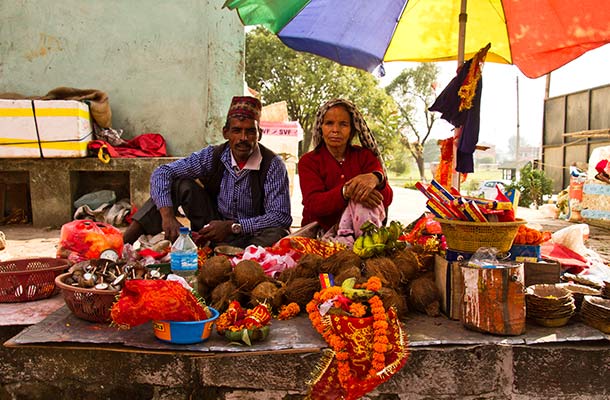Dashain: Inside Nepali Festivals
Nepal’s biggest annual festival takes place during the Himalayan kingdom’s post-monsoon period, when the sky is clearest, the air is cleanest and the rice is ready for harvesting.
 Photo © iStock/Jules2013
Photo © iStock/Jules2013
Location
Kathmandu, Nepal
Dates
Fifteen days ending on the full moon in late September/early October.
Description
Against this breezy background, followers of the goddess Durga carry out the year’s largest-scale animal sacrifices, to satiate the bloodthirsty Hindu deity. Also known as Durga Puja, the festival celebrates Durga’s victory over the forces of evil, personified by the buffalo demon Mahisasura.
The fortnight begins calmly enough. Residents plant barley seeds in carefully furrowed soil; getting the seeds to sprout a few centimetres during Dashain ensures a good harvest.
On Fulpati (‘Sacred Flowers’), the first really important day, a jar of flowers is carried from Gorkha to the Tundikhel parade ground in Kathmandu, where it is presented to the king. The flowers, which symbolise Taleju, the goddess of the royal family, are transported on a palanquin to Hanuman Dhoka (the old Royal Palace) and inspected again by the monarch and his entourage.
The next day, Maha Astami (‘Great Eighth Day’), ends with Kala Ratri (‘Black Night’), when the sacrifices and offerings to Durga begin. The hundreds of goats contentedly grazing in Kathmandu’s Tundikhel parkland are living on borrowed time. At midnight, in a temple courtyard near Durbar Sq, eight buffaloes and 108 goats are beheaded, each with a single stroke of the sword or knife.
More sacrifices take place the following day (Navami) at Kot Sq, also the scene of a massacre of noblemen in 1846. Visitors can witness the bloodshed, but you’ll need to arrive early to secure a place. Blood is sprinkled on car wheels to ensure a safe year on the road. At the airport, each Royal Nepal Airlines Corporation aircraft has a goat sacrificed to it. At dinner, almost everybody in the country will find that goat is on the menu.
Thankfully, the bloodletting is now over and the 10th day, Vijaya Dashami, is a family occasion. Cards and greetings are exchanged and parents place a tika on their children’s foreheads. In the evening, processions and masked dances take place throughout the Kathmandu Valley to herald the end of Dasain. For the Kharga Jatra (sword procession), priests dress up as Hindu gods and carry wooden swords, symbolising the weapon Durga slew Mahisasura with. Like India’s Dussehra festival, the day also celebrates Lord Rama’s victory over the 10-headed demon-king Ravana. The barley sprouts that were planted on the first day are picked and worn as small bouquets in the hair.
Kartika Purnima, the full-moon day marking the end of the festival, is celebrated with gambling in many households. Even the children get involved, putting down a few rupees on games of chance.
Level of Participation
2 – steel yourself for mass sacrifices and a procession of swords.
Other Local Attractions
Bodhnath in Kathmandu is Nepal’s most revered Buddhist monument, a white stupa crowned with a golden spire and the eyes of Buddha.
Travel Safety Tips
The Dashain festival is generally considered pretty safe for humans - if you are a goat however...
All jokes aside, if you are squeamish or have a problem with animal cruelty it's best to give the eighth day (Maha Astami) of celebrations a miss. It's out in the open, it's bloody, and there is a lot of it.
Also, at this festival there is a great mass of human traffic that you will need to deal with. It's an important festival for the Nepalese people - probably the most important festival of the year - so expect there to be large crowds and lots of chaos.
More Info: Nepal Tourism Board
Related articles
Simple and flexible travel insurance
You can buy at home or while traveling, and claim online from anywhere in the world. With 150+ adventure activities covered and 24/7 emergency assistance.
Get a quote
No Comments